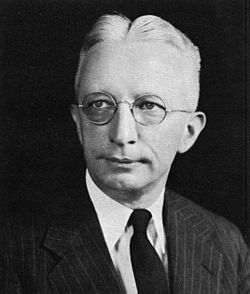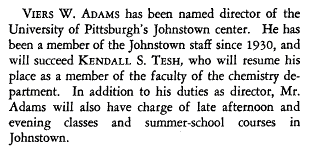UPJ History - The Early Years 1927- 1959
|
The University of Pittsburgh first established a presence in Johnstown, PA prior to World War I when the Johnstown School Board asked the university to offer continuing education courses at extension class sites in local teachers' institutions.
By 1926, a more permanent relationship was sought by the school board, and UPJ was officially founded as a two-year college of the University of Pittsburgh on September 24, 1927. Throughout the 1920s and 1930s it held classes in the Johnstown High School building in the Kernville section of downtown Johnstown. After World War II, the Johnstown College moved to the Moxham section of town where the number of courses and students increased. |
Executive Heads
Johnstown Center of the University of Pittsburgh
Presidents of the University of Pittsburgh at Johnstown
|
In the early 1960s, community leaders worked with the University of Pittsburgh to build a new campus in Richland Township, a Johnstown suburb. The new campus opened in 1967 with two classroom buildings, five dormitories, and a student union.
Degree-granting status was awarded to UPJ by the University of Pittsburgh in 1970. The campus has grown significantly since that time with five academic buildings, a library, an expanded student union, a sports and aquatic center, a conference center, a chapel, a performing arts center, and a large cluster of dormitories, lodges, townhouse apartments and other student residence housing. UPJ now offers over 40 baccalaureate and associate degree programs.
Degree-granting status was awarded to UPJ by the University of Pittsburgh in 1970. The campus has grown significantly since that time with five academic buildings, a library, an expanded student union, a sports and aquatic center, a conference center, a chapel, a performing arts center, and a large cluster of dormitories, lodges, townhouse apartments and other student residence housing. UPJ now offers over 40 baccalaureate and associate degree programs.
Below is the early history of UPJ prior to the founding of any Greek Organizations.
Early Years 1927 - 1959
1930
1931
1932
1933
- January 10: First issue of the student newspaper, The Panther Cub, is published. Dr. Daniel Auchenbach organizes a Glee Club, which remains active for a decade. The newspaper’s first editors introduced it as “a chronicler of college news.” It remained known as "The Panther Cub" until 1958 when it was renamed "The Panther" and in 1974 it became "The Advocate."
- Pitkin Club, a student organization of a quasi-religious nature, is organized by the students to discuss current public issues or philosophical topics dealing with morality or religious tenets.
1931
- November 19: Phi Theta Kappa (Beta Mu Chapter), a national junior college honors fraternity, is chartered. It remains active until the 1970s.
1932
- Spring: For economical reasons, the students vote by a 10-1 margin to abolish all competitive athletic teams in favor of intramural teams representing education, business, engineering, arts and sciences, and pre-professional studies.
- In addition to day classes, evening courses for adult students are offered.
1933
- July 1: Dr. Kendall Tesh succeeds Dr. Crawford as Executive Head, upon Dr. Crawford’s transfer to the Oakland campus.
|
1936
1937
|
1942
1945
1946
1947
1951
1952
1953
1956
1958
1959
1960
- September: 28 tuition-free courses to benefit future servicemen as well as wartime civilian workers are offered through the Engineering, Science and Management War Training Program.
1945
- January 19: Claire A. Anderson becomes Head of the Johnstown Center as Mr. Adams leaves to pursue a doctorate degree at the University of Chicago.
1946
- September 1: Johnstown Center moves to the former Cypress Avenue Elementary School in Johnstown’s Moxham neighborhood. The students nickname the location “the asphalt campus.”
- Fall: 650 full-time students are enrolled, of which 550 are World War II veterans. Saturday classes are added to the daily schedule.
1947
- February: Enrollment is nearly 1000 with 850 being full-time students.
- May 23: A war surplus building is requisitioned for spill-over classes to accommodate the large influx of veterans. The building also houses the cafeteria, engineering drafting room, bookstore, and offices.
1951
- October 8: An Air Force Reserve Officers Training Corps is created and remains a feature of the college for the next 15 years. The Pershing Rifle drill team, an element of the reserve unit, competes against similar units at other colleges.
1952
- May: Johnstown Center celebrates 25 years. 82 members of the charter class attend a banquet at the Sunnehanna Country Club.
1953
- October 12: Mr. Anderson voluntarily steps down as Head of Johnstown Center. A welcome dinner and reception for his successor, Dr. George W. Hoffman, is held on October 23. Dr. Hoffman assumes his duties on October 26.
1956
- Mercy Hospital of Johnstown sends 46 nursing students to the Johnstown Center for the first time. The Center also institutes entrance and placement examinations for new freshmen.
1958
- "The Panther Cub" newspaper renamed "The Panther" It would remain being called this until 1974 when it became "The Advocate"
- February: Dr. George Hoffman leaves to serve as Director of the Bureau of Higher Education in the Department of Public Instruction in Harrisburg. Former Executive Head Claire Anderson is recalled from his faculty position to become “acting director.”
- July 1: The Johnstown Center is renamed Johnstown College of the University of Pittsburgh. Dr. Theodore W. Biddle assumes his duties as Johnstown College’s first president.
- September: Johnstown College starts its earliest fall term as it switches to a Trimester Academic Calendar. The first experimental program, “early admission” for current high school students, is implemented.
1959
- April 24: Honors Day. Speaker: Alan C. Rankin, D.S.S., Assistant Chancellor-General Affairs, University of Pittsburgh.
- September 21: The student newspaper, The Panther Cub, shortens its name to The Panther.
1960
- March 9: Honors Day. Speaker: Edward H. Litchfield, Ph.D., Chancellor of the University.
Compiled from "The Evolution of a College" by Robert J. Hunter, Delta Chi, The Advocate, The Johnstown Tribune-Democrat, and various other sources in the Pitt-Johnstown Archive at Owen Library.



